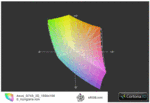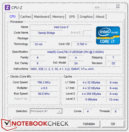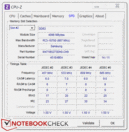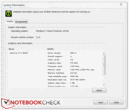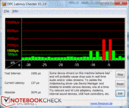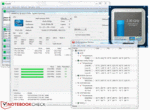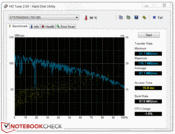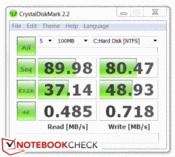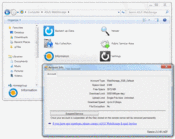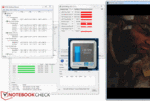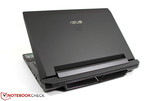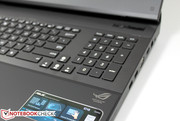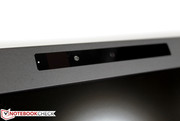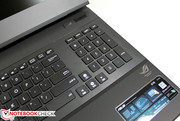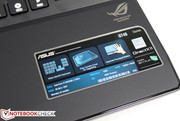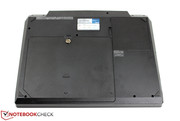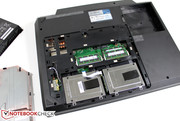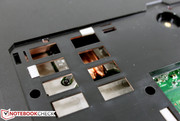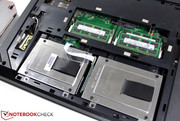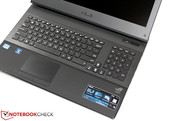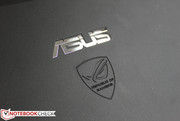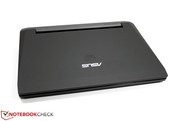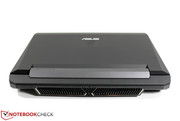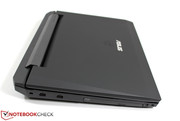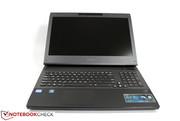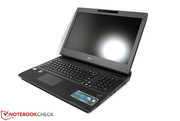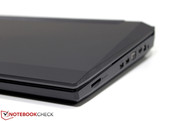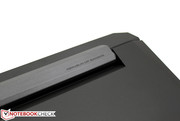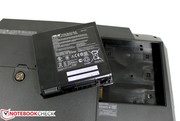Review Asus G74SX-3DE Gaming Notebook
Believe it or not, gaming notebooks have worked their way into a permanent place in notebook heaven. No wonder when looking closer at the used hardware – a solidly configured desktop computer is needed to serve as an equal in terms of performance reserves. Ultimately, a laptop has a decisive advantage in terms of portability and power consumption.
The Taiwanese manufacturer, Asus, is at the far front here with its G series. The G53/G73 notebooks had already made themselves a reputation due to their atypical low noise level. The refresh, as the G74S, thus sees itself faced with high expectations in a range of criteria.
Our test device's key data sound very promising: Intel Core i7-2630QM CPU, Nvidia GeForce GTX 560M graphics card fused with a full 12 GB of main memory and a 1.5 terabyte hard disk capacity. The screen is a surprise: 1920x1080 pixels, Full HD with 3D function and a matt! surface. And, interested? We've checked what this notebook is really capable of.
Case
The fan community can relax. Nothing has really been modified on the basic Asus G series design. The stealth theme is still vital for the device's looks, even if minute changes have been made here and there in comparison to the predecessor.
The soft finish surfaces still bid an outstanding feel. In view of durability and intensive gaming use, you can only hope that it stays that way and no signs of deterioration turn up sooner or later. The case is quite resistant against dust particles and fingerprints. However, when dirt has gathered, you should use a moist cloth since the usual micro fiber cloths rub across the rubber coated surfaces with little effect.
The case's stability proves to be good. We can provoke slight deformations, which partly also cause quiet creaking noises, under selective pressure. However, the overall impression is more than satisfactory even in view of workmanship.
The display only has a limited opening angle (135°) due to its design. Nevertheless, this is more than sufficient for a desktop replacement notebook on the desk. The fact that the screen doesn't have a latch for the closed state can also be tolerated in view of the device's size.
Connectivity
Let's start with the available interfaces. Both the front edge, as well as the rear are exempt from accommodating the according connections. Thus, there are only the sides left, which are, however, equipped rather sparsely. The audio ports (headphone, microphone) are found on the front left edge. They are followed by the optical drive, a BluRay drive in the case of our test device, two USB 2.0 ports and the Kensington lock. On the opposite side, you may be glad about a card reader, one USB 2.0 and one 3.0 port, a VGA, a HDMI, LAN and the network interface in the rear area. The transfer rate at the USB 2.0 port has an average of 28.1 MB/s in the test.
In our opinion, the port distribution is acceptable. Especially, the relatively large space between the USB ports can deter possible complications. However, we aren't very happy with the quantity of port options considering that it is a top of the range gamer. Interface options, such as eSATA, Firewire or display port, have been left out just like an ExpressCard slot for possible individual expansions.
Nevertheless, the Asus G74SX has all necessary ports that a cutting edge gamer should have and doesn't place them disadvantageously for the user.
Communication/Software + Supplies/3D/Warranty
The Asus G74SX is apt for the next LAN party with LAN (Realtek Gigabit Ethernet) and WLAN standard a/b/g/n (Atheros AR9002WB). Bluetooth 3.0 is also part of the team.
The laptop has several very helpful programs in its state of delivery, for example for rendering 3D media. Classic bloatware is kept within limits on our test system to an extent.
Speaking of 3D: A main feature of our test device is the possibility to render 3D content thanks to the 120Hz display. Stereoscopic 3D has to be enabled, respectively set up via Nvidia's Control Panel beforehand. If you have the appropriate shutter glasses at hand, you can start watching right away. It wasn't part of our test sample's scope of delivery, but it is included for the retail devices. The glasses cost around 70 euros when bought separately. The corresponding emitter is built into the display in the webcam's vicinity.
The manufacturer's warranty is a 24 month pick-up & return service and is thus in the usual period.
Input Devices
Keyboard
A modification has also been made on the keyboard in comparison to the previous G73. A change for the better, we think. The single key layout (chiclet) has been maintained, as well as the availability of a separate number pad. But it has been slightly moved away from the other keys and leaves more room for the arrow keys. These have also been separated from the other keys horizontally. The arrow keys' size equals the normal keys. By the way, the gap of the entire keyboard unit is filled by an aluminum plate, which should even withstand an uninhibited thrashing around on the keyboard.
The entire keyboard unit can be described as being well fitted into the case in terms of typing feel. The single keys have a comparatively short key drop with a nevertheless clear pressure point. The keys even stay pleasantly quiet even when you hit them hard. Even if Apple fans don't want to believe it, the keyboard unit installed into the G74SX comes very close to the aluminum bolides in terms of typing feel. A minor complaint is due for the audibly quiet and palpable creaking that turned up at the odd time. However, it doesn't result in any real obstacle. There are no hot keys on the G74. All functions are incorporated in the F-keys' area and can be opened there via Fn-key combinations.
The keyboard also has a backlight that can be dimmed in three levels. It improves the keys' legibility in dark surrounding extremely.
One issue might still be interesting for gamers in the case of the G74SX: Ghosting, thus the behavior when not all pressed keys are recognized or forwarded. This is especially a criterion in the AWSD key area, for example when you run at an angle and want to shoot at the same time in Fifa. Our tests didn't show any restrictions in Fifa's default settings However, the combinations AWSD-Q and AWD-Q didn't work in detail, for example.
Touchpad
The hardware used is the until now still unknown Sentelic Sensing pad with the driver version 9.0.2.7. The pad is sufficiently sized with dimensions of 10.5x6.3 centimeters and also basically has good gliding traits. Even both corresponding mouse keys can be used pleasantly with a clear key drop.
Scrolling with two fingers on the pad (multi-touch) is basically possible, but not implemented very well. No tested program (browser, Explorer) responded smoothly or immediately to our input attempts.
Apart from that, the touchpad is set to be disabled and stay that way for a short time when a key is pressed ex-factory. This isn't helpful in games without an additional mouse and a complete pad disabling (Fn+F9) would make more sense. However, this function helps prevent unintentional mouse clicks during typing in office mode.
Display
One point where good notebooks (unfortunately) fail very often is the display. A too low brightness, a miserable contrast or disagreeable and annoying reflections even indoors due to fashionable glossy displays. The recipe for satisfaction seems simple with that in mind. However, the fact that of all things a gaming notebook lines up to serve this with near perfection does surprise us.
Asus installs a 3D capable 120 Hertz display, which astonishingly comes along with an AR coated surface, into the G74SX. Despite all prophecies of doom, in the way of low contrast, lack of brilliance, etc., we measure an extremely low black value of 0.57 cd/m2 in combination with an excellent maximum brightness of 393 cd/m2. The result: A just as outstanding contrast of 689:1.
Lessons have been learned in things of resolution as well. The screen has a native Full HD resolution of 1920x1080 pixels and thus allows the best possible viewing experience in games and picture reproduction. Naturally, that isn't very suitable for the 3D mode in games since the performance reserves of the installed GPU aren't sufficient for this. On the other hand, who wants to sit in front of the notebook permanently wearing 3D glasses or live with 1366x768 pixels the "rest of the time", as it was often the case in the past?
| |||||||||||||||||||||||||
Brightness Distribution: 78 %
Center on Battery: 393 cd/m²
Contrast: 689:1 (Black: 0.57 cd/m²)
71% AdobeRGB 1998 (Argyll 3D)
97.4% sRGB (Argyll 3D)
69.5% Display P3 (Argyll 3D)
Finally, a look at the reproducible color spectrum confirms that the installed display (LGD02C5) isn't just another run of the mill screen. The near coverage of the sRGB color spectrum can be seen well in the comparison. It clearly surpasses low-end, mainstream displays and the 3D screen might even satisfy hobby graphic designers and picture editors.
Although this scenario will likely not be the case for a 17 inch gamer, even the sun worshippers in the gaming community could be pleased about the installed display. The matt screen, together with the high brightness (100% available even with battery only), allows outdoor use even under the blazing sun. The displayed picture always remains perfectly visible.
The Asus G74SX can serve with a generous work field in terms of stable viewing angles. While even very narrow viewing angles can be easily dealt with on the horizontal plane, image deviations turn up sooner vertically. Nevertheless, the screen proves to be very generous and remains stable for a longer time in comparison to standard notebook screens.
Performance
The Asus G74SX, along with the MSI GT780 and the Clevo P150HM, belongs to one of the first laptops that have Nvidia's newest graphics solution, the Geforce GTX 560M. Our first tests with the Schenker P501 show an average performance increase of about 13% in comparison to the previous chip, GTX 460M. This is primarily due to the increased clock rates of 775/1550 MHz (+15% compared to the GTX 460M). The used GF116 chip has been optimized in terms of power requirement in comparison to the GT106. This is also necessary in the case of the Asus G74SX because the device unfortunately doesn't make use of Nvidia's Optimus and thus always falls back on the dedicated graphics solution. Intel's HD Graphics 3000, which is always part of the team since it's on the built-in i7-2630QM, gets bored and remains idle in the G74SX. In-depth information about the installed GTX 560M graphics card from Nvidia and the HD Graphics 3000 from Intel can be found on our linked detail pages.
The built-in Intel i7-2630QM quad core CPU is a member of the Sandy Bridge range and thus has many exciting features, such as Hyper Threading (8 threads) and Intel's Turbo Boost 2.0. The chip, as the smallest representative, is an attractive choice in view of the performance for money ratio and is used in many powerful consumer notebooks in the meantime. You can also find in-depth information about the chip's technology on our detail page about the Intel i7-2630QM CPU.
The configuration, as it lies before us, can indubitably be classified as high-end An awesome 12 GB of main memory and even two swift 7200 rpm hard disks with a capacity of 750 Gigabyte each join in on the 2630QM and GTX 560M graphics solution. You can discuss the sense or non-sense of the main memory configuration. But hard disk capacity never hurts. The distribution of the memory capacity over a total of four partitions is cause for a bit of bewilderment.
Be that as it may, the Asus G74SX is clearly aimed at the demanding gamer with an inclination for portable devices. The installed Full HD display should be fueled with a sufficiently smooth frame rate for indulging into a stutter-free experience in almost all current games. The matter quickly changes in 3D and gaming. As various tests that we executed in the run-up showed, Nvidia's 3D Vision swallows about 50% of the performance and thus reduces the selectable resolution and graphic detail level down. Details about Nvidia's 3D Vision can be found in this review.
CPU Performance
In the meantime, there is a vast amount of benchmarks concerning the installed i7-2630QM. Nevertheless, we would like to take a detailed look at the CPU performance with Cinebench R10 and R11.5 Rendering – in particular regarding Intel's Turbo 2.0's behavior. Intel's Turbo Monitor tool records an almost constant 2.6 GHz in the first run through of CB R11.5 (cold device) while Cinebench puts all cores, respectively threads under load. The clock rate drops to 2.5 GHz only a few seconds before the benchmark test is finished. Result: 4.61 fps. Consequently, the G74SX places itself in the midfield of all reviewed notebooks with a 2630QM CPU.
The clock rate's decline from the maximum of 2.6 GHz to 2.5 GHz can be observed at roughly the middle of the test's subsequent re-run. The Intel tool even records 2.4 GHz in the last few seconds. These apparently are the first signs that the Turbo is no longer constantly 100% effective due to the lack of cooling reserves. But it is immediately followed by a surprise: The total score is 4.92 fps - only just behind the maximum entries of 5.0 fps for the i7-2620QM in our database. Another test shows just about the same clock rate course. It can boost the total score slightly to 4.96 fps.
A clock rate of 2.7 to 2.8 GHz is observed in the Cinebench R10 (64bit) Single Core Rendering test. So, not the CPU's maximum possible 2.9 GHz. A look in the task manager shows light load on four threads at the same time. The result is adequate. With 4438 points, the G74SX is at the lower end compared with notebooks that have the same CPU. The same phenomenon can be seen in the CB 10 32 bit test. It is again confirmed in the SuperPi benchmark test. The CPU can't go beyond 2.8 GHz and the result of the 32M test is also sooner in the lower third of compared devices with a 2630QM with 733 seconds here. By the way, according to our observations, it doesn't matter if Windows' high performance energy profile or Asus' high performance Power4Gear is selected.
According to the Intel tool and HWINFO, the clock rate decreases from the initial 2.6 GHz to 2.3 GHz after about 15 seconds when we load the G73SX with Prime95 (all cores/threads under load). The CPU ultimately stays at this level for the entire remaining testing period (about 30 minutes). A Cinebench R11 CPU benchmark test executed immediately afterwards finally records a result of similar 4.96 fps.
In contrast to all other reviewed laptops with the same CPU, no conspicuous losses due to excessive Turbo throttling could be observed in the multi core optimized tests. However, the G74SX obviously doesn't exploit the i7-2630QM's maximum possible clock rate when only one core is put under load. It also only remains at the lower end of identically equipped comparison devices in the according benchmarks. We check if this behavior also has an impact on practical use with the following tests.
System Performance
Even if gamers won't be quite as interested in this part of the review, and it's hard to imagine that the G74SX won't supply enough performance for any end user scenario in view of the installed hardware, we would like to take a look at the system's overall performance for the sake of completeness.
PCMark Vantage delivers a total score of 7227 points. MSI's GT780R can provide a clear distance with 8599 points here. Schenker's P501 PRO even delivers 16956 points - thanks to the built-in SSD. Basically, you will find multimedia and gaming machines from all manufacturers in the G74SX's immediate vicinity - usually based on Sandy Bridge, though.
The HDD score rewards both conventional 7200 rpm disks with an average result of 4239 points. The idea of combining a solid state drive (SSD) with a conventional hard disk for achieving a good and proper performance boost is close. This should even be possible for a non-expert thanks to both hard disk slots.
Our Asus G74SX configuration achieves a total score of 2486 points in the brand new PCMark 7. Thus, it only lags a bit behind the MSI GT 780R (2516), but has to clearly surrender to the Schenker P501, which is however, equipped with a SSD and a 2720QM CPU: 4208 points.
| PCMark Vantage Result | 7227 points | |
| PCMark 7 Score | 2489 points | |
Help | ||
GPU Performance
We have previously looked closer at the new GeForce GTX 560M from Nvidia in the MSI GT780R and Schenker P501. Thus, we especially want to check if the hardware can also develop its full performance potential in this configuration in the Asus G74SX at hand.
The G74SX achieves a plausible score in the older 3DMark 2006 (1280x1024) with 15216 points, but is extremely close behind the GT780R (15369) and Schenker P501 (15844). The GTX 460M's best result in the Medion X6813 lags behind by 7%. The GTX 485M in the Schenker P501 has the lead by 28%. AMD's Mobility Radeon HD6970 is 13% in front of the GTX 560M. The HD5870 is behind by 18%, however still with an Intel Clarksfield CPU.
The CPU's impact even shrinks in the 3DMark Vantage benchmark test and the GPU proves to be the main reason for the result. Basically, the picture is repeated anyway. The G74SX only remains slightly behind the MSI GT780R (9314) with 9227 points, just like the P501 (9425). Both with the same CPU, mind you.
When we go up a step, for example in 3DMark 11, the three opponents move closer except for a few points: Asus G74SX: 1759 points, P501: 1763 points, GT780R: 1783 points. Interesting: Apart from a few points, the Medion X6813, with a GTX 460M GPU and the same CPU, can come close to the GTX 560M bolide with 1731.
We use the Unigine Heaven 2.1 benchmark as the last test reference. It especially demands the DirectX 11 features (tessellation). The Asus G74SX lags slightly behind with 26.9 fps. Both the GT780R and the P501 can excel slightly with 27.6, respectively 27.7 points here.
| 3DMark 2001SE Standard | 41315 points | |
| 3DMark 03 Standard | 37888 points | |
| 3DMark 05 Standard | 22198 points | |
| 3DMark 06 Standard Score | 15216 points | |
| 3DMark Vantage P Result | 9227 points | |
| 3DMark 11 Performance | 2040 points | |
Help | ||
HDD Performance
We will take a closer look at both installed hard disks in the last part of our general performance assessment. The hard disks come from Seagate and have been named ST9750420AS. The user has a total memory capacity of 1.5 terabytes available due to a gross capacity of 750 GB each. At least on paper, because the operating system naturally reserves itself an according part of this apparent excess. Should this not be enough, Asus also offers a 3GB web storage for free, which allows saving single documents in Cloud, for example.
HDTune gives the built-in hard disk array a very good and low access rate of 15.8 milliseconds. The average transfer rate of 87.1 MB/s is also impressive. Actually, the only things that can improve this is a hybrid drive or a SSD. Asus likely doesn't use the latter in order to simply reach the G74SX's price target.
A hardcore gamer also wants to show its gaming performance. Thus, we now come to the practical part. As usual, we check the hardware with many current and known games. A comprehensive overview of how well various games run on the Nvidia GTX 560M can be found on the GTX 560M graphics card's detail page. Our GPU game comparison provides a comprehensive comparison with other current graphic cards and frame rates of the most various resolution levels.
Dirt 3
Let's start with a both new and demanding game, Dirt 3. The games built-in benchmark test supplies an average of 22.6 frames per second in ultra settings (FHD, ultra presets). That may not sound smooth, but the frame rate doesn't stutter subjectively. The frame course shows that the G74SX stays constantly above 20 fps here. In high settings (1366x768, high), the frame rate soars up to 82.3 fps, but stays slightly behind its equally configured colleagues, MSI GT780R (85 fps) and Schenker P501. In comparison: A Geforce GT 540M achieves about 39 fps (Asus K53SV), a mobility Radeon HD 6570M: 53 fps (Ideapad Y560p).
| Dirt 3 | |||
| Resolution | Settings | Value | |
| 1920x1080 | Ultra Preset, 4xAA, -AF | 22.57 fps | |
| 1360x768 | High Preset, 2xAA, -AF | 82.3 fps | |
| 1024x768 | Medium Preset, 0xAA, -AF | 118.9 fps | |
| 800x600 | Ultra Low Preset, 0xAA, -AF | 186.6 fps | |
Mafia 2
The well-known Mafia 2 also doesn't necessarily treat resources sparingly and beyond that, it has a standardized, built-in benchmark test. No problem for the Asus G74SX, which easily copes with it even with the maximum hardware requirements (FHD, high presets). The gaming notebook can even distance itself from both aforementioned opponents with 49.0 fps: + 15% to the Schenker P501 and the MSI GT780R. Consequently, the GTX 560 is on a par with the GTX 470M in the Deviltech Fragbook, for example. The previous GTX 460M comes close with 39.2 fps (Alienware M17x R3). That corresponds to a lead of about 20% for the GTX 560M.
| Mafia 2 | |||
| Resolution | Settings | Value | |
| 1920x1080 | high, 0xAA, 16xAF | 49 fps | |
Starcraft 2
You are also perfectly served with the Asus G74SX if you want to see your strategy games with their best possible graphics quality. Our in-game run through reveals an average frame rate of 35 fps in the highest graphic details (FHD, ultra). Both the GT780R, with 35.2 fps, and the P501 (34.7 fps) are practically on a par. The GTX 460 in Alienware's M17x R3 also wants to belong to the absolute upper league here and delivers an impressive 34.5 fps. The GTX 470M, for example in Schenker's U700, can excel here a bit and reaches 40.5 fps (+16%).
| StarCraft 2 | |||
| Resolution | Settings | Value | |
| 1920x1080 | ultra | 35 fps | |
Battlefield: Bad Company 2
Finally, action in its highest standard is also shown on the battlefields of BF: BC2. The Asus G74SX places itself slightly before its rivals (P501: 34.4 fps, GT780R: 34.3 fps) with 35.0 frames per second in the highest graphic details (FHD, high, 4xAA, 8xAF, HBAO). The GTX 460M only lags behind by 10%. The GTX 470M is up to 10% faster, depending on the comparison device. AMD's HD 6970M takes the lead with +42%. Its predecessor, the HD 5870, is left behind by about 5%. Midrange graphic cards, the like of a GT 540M or HD 6650M, hardly achieve 50% of the GTX 560M's and remain in an absolute unplayable range in these settings at about 16 fps.
| Battlefield: Bad Company 2 | |||
| Resolution | Settings | Value | |
| 1920x1080 | high, HBAO on, 4xAA, 8xAF | 35 fps | |
| 1366x768 | high, HBAO on, 1xAA, 4xAF | 66 fps | |
Verdict: Gaming Performance
By and large, you can be happy with the GTX 560M's performance. The GPU can display current games smoothly across the board in the highest resolution and graphic details with few exceptions (Metro 2033, Crysis 2) in the preceding tests. The Full HD display in the G74SX can therefore be enjoyed to the full, but only in 2D mode. You have to reckon with a decrease of about 50% in the recorded frame rates when Nvidia 3D is enabled since the reproduced picture has to be calculated twice. 3D in Full HD in games will only be possible with a few tracks and then likely only with extremely limited graphic details.
To what extent the GTX 560M can surpass its predecessor depends on each game and then probably also on the used graphics driver. The just released Geforce GTX 580M will likely provide new performance records, but the price will also be located in the absolute top field. An option for more power at a reasonable extra cost would thus be AMD's Mobility Radeon HD 6970M. However, it's hardly ever found in laptops, for example in Alienware's M17x R3 or also in the Eurocom Racer.
| low | med. | high | ultra | |
|---|---|---|---|---|
| Half Life 2 - Lost Coast Benchmark (2005) | 228.5 | |||
| World in Conflict - Benchmark (2007) | 32 | |||
| Crysis - GPU Benchmark (2007) | 62.2 | 14.9 | ||
| Supreme Commander - FA Bench (2007) | 43.3 | |||
| Sims 3 (2009) | 78 | |||
| Anno 1404 (2009) | 52 | |||
| Colin McRae: DIRT 2 (2009) | 47 | |||
| Resident Evil 5 (2009) | 143.5 | 56.6 | ||
| Risen (2009) | 31 | |||
| Battlefield: Bad Company 2 (2010) | 66 | 35 | ||
| StarCraft 2 (2010) | 35 | |||
| Mafia 2 (2010) | 49 | |||
| Fifa 11 (2010) | 149 | |||
| Dirt 3 (2011) | 186.6 | 118.9 | 82.3 | 22.57 |
Emissions
System Noise
Apparently, Nvidia couldn't really sell its Optimus solution to Asus this time around, either. Alike its predecessor, the G74SX doesn't use the automatic graphics switching and thus falls back on the dedicated GTX 560M graphics card in all modes of operation. Nevertheless, the Asus G range has built up a reputation with its extremely quiet operating noise, not only among noise sensitive persons.
We ultimately have the according expectations on the present G74SX gaming laptop, as the newest sprout in the range. But alas, it becomes apparent just only after turning on the computer that the notebook has not only gained performance reserves, but that the noise emissions have also increased significantly. We measure a constant 35.4 dB(A) in idle, respectively office mode. This is still nominally acceptable, but you will have to live with a permanently audible system that whirrs along subjectively.
One of the testing editors also thought he could hear a slightly irregular run of the fan, or one of the fans. However, this can be neglected and can be at most heard in an absolutely quiet surrounding with concentrated, trained ears if at all.
It won't bother the gamer much. Instead, he will be happy about a surprisingly quiet system during load operation. The fan virtually remains unimpressed in some games, respectively settings, and no changes in noise can be detected. Nevertheless, we can observe a slight increase in speed and thus the device's noise in a several hour stress test via Battlefield BC2. The measured maximum rate of only 38.1 dB(A) is still looking for its equal among gaming colleagues. Schenker's P501, with the same hardware, turns up to 46.1 dB(A) during load and the MSI GT780R isn't really quieter with up to 44.8 dB(A).
Noise level
| Idle |
| 35.4 / 35.4 / 35.4 dB(A) |
| HDD |
| 36.4 dB(A) |
| DVD |
| 38.6 / dB(A) |
| Load |
| 37.5 / 39.5 dB(A) |
 | ||
30 dB silent 40 dB(A) audible 50 dB(A) loud |
||
min: | ||
Temperature
Quiet systems are often paid for with high case temperatures because this way the excess heat can be discharged out of the case into the surroundings without having to keep a fan running at its maximum speed. Asus uses a completely different approach here. The heat inside can be discharged in a simple yet efficient way due to the use of two fans, the selective conducting of the cooling air stream and not least thanks to the bulky case. The case merely reaches a maximum of 40°C selectively on the bottom during load. The wrist-rests stay below the 30°C mark, just like the keyboard's left part around the AWSD keys, which is important for gaming. The rates also hardly surpass the 30°C mark in idle mode or light office load.
What does it look like inside the Asus G74SX? Well, unsurprisingly not really more dramatic than on the case's surfaces. We can record the components' maximum temperatures in the stress test with BF:BC2, as so often. According to the tool CPUID Hardware Monitor, the CPU heats up to a maximum of 67-74°C. Even if these rates are ultimately only estimated, they show that there is still enough room upwards in any case. Meanwhile, the GTX 560M GPU settles to a similar level: 62-64°C are also pleasant operating temperatures for the graphics chip.
Thus, you may think that the throttling issue has no impact on the Asus G74SX – Unfortunately, no. The laptop obviously doesn't feel well at all in our usual stress test via Prime95 and Furmark. The CPU can cope fairly well with only Prime. The core temperature don't surpass 64°C according to HWMonitor. The clock rate stays constant at almost 2.4 GHz. When the Furmark GPU stress test is enabled, the CPU immediately throttles 800 MHz. The GPU clock rates aren't affected by this, though.
In order to check if a game can also trigger this behavior, we opted for a stress test with Battlefield Bad Company 2. According to previous measurements, it also places the highest demand on CPU and GPU. The CPU frequency remained constant at 2.6 GHz even after about an hour of gaming in high graphic demands (FHD, high, HBAO), and thus at its upper limits when four cores are loaded. The corresponding fps diagram also doesn't give reason for concern.
Since neither the observed chip temperatures nor the practical gaming test indicated throttling, the manufacturer has perhaps intentionally built-in a kind of safety stop that however only catches in the unrealistic stress test. No correlating BIOS settings could be identified in this regard, though. The tool, ThrottleStop also made it possible to suppress downclocking in the stress test. However, this didn't have an impact on the executed CPU benchmarks. The chip temperatures increase insignificantly up to 77°C for the CPU and 72°C for the GPU in the stress test with disabled throttling (according to HWMonitor).
(+) The maximum temperature on the upper side is 34 °C / 93 F, compared to the average of 40.4 °C / 105 F, ranging from 21.2 to 68.8 °C for the class Gaming.
(±) The bottom heats up to a maximum of 40 °C / 104 F, compared to the average of 43.3 °C / 110 F
(+) In idle usage, the average temperature for the upper side is 28.4 °C / 83 F, compared to the device average of 33.9 °C / 93 F.
(+) The palmrests and touchpad are cooler than skin temperature with a maximum of 30 °C / 86 F and are therefore cool to the touch.
(±) The average temperature of the palmrest area of similar devices was 28.8 °C / 83.8 F (-1.2 °C / -2.2 F).
Speakers
The predecessor, Asus G73, could present quite a bit in terms of sound. The most music genres sound absolutely worth listening to on the laptop. The soundscape can also basically convince in games. In our opinion, a possible reason for complaint could be the speakers' somewhat too low maximum volume, in particular during music playing. External audio rendering devices can be connected via the HDMI port or the 3.5 mm stereo jack (front left) and increase the quality and volume.
Battery Life
Let's first take a look at the recorded power consumption. The gamer treats itself to between almost 30W and a bit more than 40W in idle mode. Here, the display is striking since it is noticed with a fluctuation of about 8w between minimum and maximum brightness. The Asus G73SW, with a GTX 460M and the same CPU, positions itself between 20 and 30 watts, so almost 10W less. A major part of the surplus consumption can likely be ascribed to the screen's increased requirements due to a roughly twice as bright 120Hz display. In contrast, the GTX 560M's power consumption is allegedly on a par with the GTX 460M, or slightly higher.
We record a power requirement of 120 up to a maximum of 137.1W during load. That is approximately 20W more than in its predecessor, G73SW. the Schenker P501, with an i7-2720QM CPU and the same graphics card, treats itself to 130 to 170 watts; the MSI GT780 records rates of 123 to 195 watts. Considering the observations we made (stress test, CPU Turbo limitation), a manufacturer-sided restriction could also be an explanation for these maximum power consumption differences. The included power adapter is specified up to 150W, by the way.
| Off / Standby | |
| Idle | |
| Load |
|
Key:
min: | |
The G74SX's given battery life can sooner be considered to be a fulfillment of duty rather than a real alternative. It's possible to bridge short power outages with one up to about 3.5 hours, depending on the required power. But gaming on the go without the power adapter isn't really an option.
The G74SX latest for good two hours during practical WLAN surfing (various websites, a few YouTube videos) with adapted display brightness (3 levels before maximum).
A 3DMark 2006 run through in battery mode (high performance profile) only delivered 10018 points and drained a steep 20% of capacity out of the battery, in return. The maximum possible performance thus evidently can't be exploited to full in battery mode.
Verdict
Although it looked like a "Very Good" for a long time, the Asus G74SX scratches it slightly in the end and has to be satisfied with a very good "Good". Asus has really done a good job on the G74SX and could even improve the well-known gaming range in a few areas. While the familiar surroundings are seen on the case – even if with subtle revisions - the user may take delight in a better keyboard and a top-notch display, at least in the 3D version that we tested.
The installed 120 Hertz screen lets the competition look like an old hat with an exceptionally high brightness of nearly 400 cd/m2 and just as good contrast. Beyond that, the G74SX ultimately has the potential to become the most wanted among the glossy competition with its additionally matt display surface.
The built-in hardware doesn't always meet the expectations on performance that the labels indicate. The G74SX delivers a solid performance in both applications and games and can display current tracks in the highest graphics quality smoothly most of the time. Seen in detail, the installed CPU would be capable of more in certain situations, though.
The case's temperatures stay on a constant low level. The G74 only lags somewhat behind the expectations in terms of system noise in office mode. It is surprising that the device hardly increases its speed even during high load and does its job fairly quiet.
In addition to the laptop's idle noise, the only thing left to actually complain about is the scanty interface array. Although it does its job, it doesn't really appear to be worthy for a top of the range gaming machine. You may forgive the extremely stubborn touchpad during multi-touch mode. A hardcore gamer will use a mouse in any case.
The Asus G74 belongs to the current favorite of gamers among notebook users. Possible opponents, such as the MSI GT780R or even the Schenker P501, might be able to keep up with the performance or even squeeze out a few more percent here and there. But seen as a whole, the G74SX bundle has a few advantages, such as the excellent display to name a representative.














